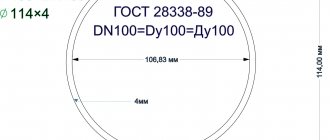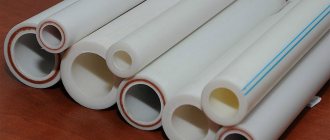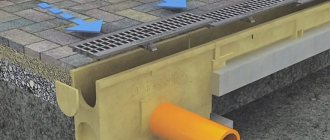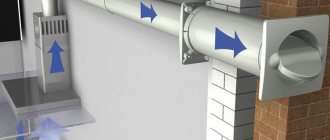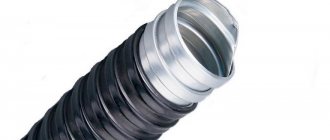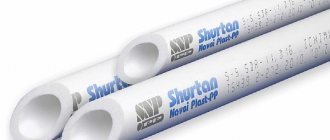How much is this in inches - nominal diameter (DN) 6-450
| DN or DN* | How much is this in inches |
| 6 | usually it's 1/8″ |
| 8 | usually it's 1/4″ |
| 10 | 3/8″ |
| 15 | 1/2″ |
| 20 | 3/4″ |
| 25 | 1″ |
| 32 | 1 1/4″ |
| 40 | 1 1/2″ |
| 50 | 2″ |
| 65 | 2 1/2″ |
| 80 | 3 « |
| 90 (very rare size in Russia) | 3 1/2″ |
| 100 | 4″ |
| 125 | 5″ |
| 150 | 6″ |
| 175 (very rare size in Russia) | 7″ |
| 200 | 8″ |
| 225 (very rare size in Russia) | 9″ |
| 250 | 10″ |
| 275 (very rare size in Russia) | 11″ |
| 300 | 12″ |
| 350 (rare, but used size in the Russian Federation) | 14″ |
| 400 | 16″ |
| 450 (rare, but used size in the Russian Federation) | 18″ |
Size (diameter) of the tap based on the diameter of steel water and gas pipes
The information provided below may be useful to you when carrying out repairs, replacing radiators, heated towel rails or installing a Hydrolock water leakage protection system. After all, in order to select a Hydrolock system, you need to know the diameter of the pipe and, based on this, select the diameter of the electric ball drive (BEP). It should be noted that steel and cast iron pipes are usually designated by their nominal diameter (internal passage), and polymer and copper pipes by their outer diameter. We won’t burden you with special technical terms, we’ll try to explain it in an accessible language.
How much is this in inches - nominal diameter (DN) 500-2200
| DN or DN* | How much is this in inches |
| 500 | 20″ |
| 600 | 24″ |
| 700 | 28″ |
| 800 | 32″ |
| 900 | 36″ |
| 1000 | 40″ |
| 1050 | 42″ |
| 1100 | 44″ |
| 1200 | 48″ |
| 1300 | 52″ |
| 1400 | 56″ |
| 1500 | 60″ |
| 1600 | 64″ |
| 1700 | 68″ |
| 1800 | 72″ |
| 1900 | 76″ |
| 2000 | 80″ |
| 2200 | 88″ |
*DN or DN can be indicated with a dimension of mm, for example “DN 50 mm”, but this is not entirely correct, it implies a dimensionless value.
Quite often, when calculating pipeline fittings, it is necessary to convert the diameter of flanges or pipes into inches. Based on the table data, the dimensions of the connecting elements will be:
- DN 6 - the size in inches is 1/8″ inch
- DN 8 - the size in inches is 1/4″ inch
- DN 10 - the size in inches is 3/8 inch
- DN 15 - the size in inches is 1/2 inch
- DN 20 - the size in inches is 3/4 inch
- DN 25 - the size in inches is 1 inch
- DN 32 - inch size is 1 1/4 inches
- DN 40 - inch size is 1 1/2 inches
- DN 50 - the size in inches is 2 inches
- DN 65 - inch size is 2 1/2 inches
- DN 80 - the size in inches is 3 inches
- DN 90 - inch size is 3 1/2 inches
- DN 100 - the size in inches is 4 inches
- DN 125 - the size in inches is 5 inches
- DN 150 - the size in inches is 6 inches
- DN 175 - the size in inches is 7 inches
- DN 200 - the size in inches is 8 inches
- DN 225 - the size in inches is 9 inches
- DN 250 - the size in inches is 10 inches
- DN 275 - size in inches is 11 inches
- DN 300 - the size in inches is 12 inches
- DN 350 - the size in inches is 14 inches
- DN 400 - the size in inches is 16 inches
- DN 450 - the size in inches is 18 inches
- DN 500 - the size in inches is 20 inches
- DN 600 - the size in inches is 24 inches
- DN 700 - the size in inches is 28 inches
- DN 800 - the size in inches is 32 inches
- DN 900 - the size in inches is 36 inches
- DN 1000 - the size in inches is 40 inches
- DN 1050 - the size in inches is 42 inches
- DN 1100 - the size in inches is 44 inches
- DN 1200 - the size in inches is 48 inches
- DN 1300 - size in inches is 52 inches
- DN 1400 - size in inches is 56 inches
- DN 1500 - the size in inches is 60 inches
- DN 1600 - size in inches is 64 inches
- DN 1700 - size in inches is 68 inches
- DN 1800 - the size in inches is 72 inches
- DN 1900 - size in inches is 76 inches
- DN 2000 - the size in inches is 80 inches
- DN 2200 - size in inches is 88 inches
Source: tehtab.ru
What are DN, Du and PN? Plumbers and engineers must know these parameters!DN – Standard denoting nominal internal diameter.
PN – Standard indicating nominal pressure.
What is Du?
Du
– formed from two words: Diameter and Conditional. DN = DN. Du is the same as DN. It's just that DN is a more international standard. Du is the Russian-language representation of DN. Now it is absolutely necessary to abandon this name for Du.
What is DN?
DN
— Standardized representation of diameter. GOST 28338-89 and GOST R 52720
Nominal diameter DN
(nominal diameter; nominal bore; nominal size; nominal diameter; nominal bore): A parameter used for pipeline systems as a characteristic of the connected parts of the fittings.
Note - The nominal diameter is approximately equal to the internal diameter of the connected pipeline, expressed in millimeters and corresponding to the nearest value from a series of numbers adopted in the established order.
What is DN usually measured in?
According to the terms of the standard, it seems that it is not strictly tied to the unit of measurement (written in the documents). But it just means the diameter. And diameter is measured by length. And because the unit of length may be different. For example, inch, foot, meter and the like. For Russian documents we simply measure in mm by default. Although the documents say that it is still measured in mm. GOST 28338-89. But it does not have a unit of measurement:
How can it not, if it does? Can you write in the comments how to understand this phrase?
It seems that it has arrived... DN (diameter number expressed in millimeters). That is, it does not have a unit of measurement, but rather contains constant values (digital discrete values of the type: 15,20,25,32...). But it cannot be designated, for example, as DN 24. Because the number 24 is not in GOST 28338-89. There are strict values in order like: 15,20,25,32... And only these need to be selected for designation.
DN is measured by the nominal diameter in mm (millimeter = 0.001 m). And if you see DN15 in Russian documents, this will mean an internal diameter of approximately 15 mm.
Conditional pass
- indicates that this is the internal diameter of the pipe, expressed in millimeters - conventionally. The term “Conventional” indicates that the diameter value is not exact. Conventionally, we assume that it is approximately equal to certain values of the standard.
The nominal bore (nominal size) is understood as a parameter used for pipeline systems as a characteristic of the connected parts, such as pipeline connections, fittings and fittings. The nominal diameter (nominal size) is approximately equal to the internal diameter of the connected pipeline, expressed in millimeters.
According to the standard from: GOST 28338-89
It is customary to choose the numbers that have been agreed upon. And you shouldn’t come up with your own numbers with commas. For example, DN 14.9 would be a designation error.
Nominal diameter
approximately equal to the internal diameter of the connected pipeline, expressed in millimeters and corresponding to the nearest value from a series of numbers adopted in the prescribed manner.
These are the numbers:
For example,
if the real internal diameter is 13 mm, then we write it as: DN 12. If the internal diameter is 14 mm. then we accept the value DN 15. That is, we select the closest number from the list of the standard: GOST 28338-89.
If in projects it is necessary to indicate both the diameter and thickness of the pipe wall, then it should be indicated as follows: d20x2.2 where the outer diameter is 20 mm. And the internal diameter is equal to the difference in wall thickness. In this case, the internal diameter is 15.6 mm. GOST 21.206–2012
Alas, we have to submit to other people's standards
Any materials imported from abroad were most often developed using a different length dimension: Inch
Therefore, most often the dimensions are oriented to inches. Usually a quotation mark is written in place of the word inch.
1 inch = 25.4 mm. Which is the same 1” = 25.4 mm.
Dimensions table.
Usually a quotation mark is written in place of the word inch.
1/2 “ = 25.4 / 2 = 12.7. But in reality, this size of 1/2 “is equal to a passage of 15 mm. More precisely it might be 14.9mm. for steel pipe. In general, dimensions may vary by a few mm. Therefore, in such cases, for accurate calculations, you need to find out the internal diameter of a specific model separately.
For example, size 3/4” = 25.4 x 3/4 = 19 mm. But we write in the documents “conditionally” DN20 - approximately the internal diameter is 20 mm.
Here are the actual sizes that most often correspond to the Russian translation.
The table shows the internal diameter in mm.
Nominal pressure PN:
More details in GOST 26349 and GOST R 52720.
Has a unit of measurement: kgf/cm2. The designation kgf means kg x s (kilogram times s). c=1. c characterizes, as it were, a force coefficient. That is, by multiplying a kilogram (mass) by force, we convert mass into force. This is a correction for meticulous physicists. If you designate kg/cm2, in principle you will not be mistaken if you assume that we perceive mass as force. Also, such a unit as kg/cm2 is erroneous in that pressure is formed from two units (force and area). Mass is another parameter. Because the mass only on the surface of the earth creates the force that presses on the earth (gravitational force). Value c=1 on the surface of the earth. And if you fly to another planet, then the force of gravity will be different, and the mass will create a different force. And on another planet the coefficient c=1 will be equal to a different value. For example, c=0.5 will create pressure twice as low.
What is PN for?
The PN value is needed to indicate to the device a pressure limit that cannot be exceeded for normal operation of the device for which this value is set. That is, when designing, the designer must know in advance what maximum pressure the device is designed for.
For example,
if the device is given the value PN15, this means that the device is designed for operation with a pressure not exceeding 15 kgf/cm2. Which is approximately equal to 15 Bar.
1 kgf/cm2 = 0.98 Bar. Roughly speaking, the PN value is approximately equal to Bar or atmosphere.
For example, if a device is given a value of PN10, then it is designed for a pressure not exceeding 10 Bar.
Determination of PN according to the standard
The highest excess operating pressure at a working medium temperature of 293 K (20 °C), which ensures a given service life (resource) of valve body parts having certain dimensions, justified by strength calculations for the selected materials and their strength characteristics at a temperature of 293 K (20 °C).
Russian standards:
GOST 26349-84, GOST 356-80, GOST R 54432-2011
European standards:
DIN EN 1092-1-2008
American standards:
ANSI/ASME B16.5-2009, ANSI/ASME B16.47-2006
| Like |
| Share |
| Comments (+) [ Read / Add ] |
A series of video tutorials on a private house
Part 1. Where to drill a well?
Part 2. Construction of a water well Part 3. Laying a pipeline from the well to the house Part 4. Automatic water supply Water supply Water
supply for a private house.
Principle of operation. Connection diagram Self-priming surface pumps. Principle of operation. Connection diagram Calculation of a self-priming pump Calculation of diameters from a central water supply Water supply pumping station How to choose a pump for a well? Setting up a pressure switch Pressure switch electrical diagram Operating principle of a hydraulic accumulator Sewage slope of 1 meter SNIP Connecting a heated towel rail Heating diagrams
Hydraulic calculation of a two-pipe heating system Hydraulic calculation of a two-pipe associated heating system Tichelman loop Hydraulic calculation of a single-pipe heating system Hydraulic calculation of radial distribution of a heating system Scheme with a heat pump and solid fuel boiler - logic of operation Three-way valve from Valtec + thermal head with remote sensor Why the heating radiator in an apartment building does not heat well How to connect the boiler to the boiler?
Options and connection diagrams DHW recirculation. Principle of operation and calculation You are not correctly calculating the hydraulic needle and collectors. Manual hydraulic calculation of heating. Calculation of a warm water floor and mixing units. Three-way valve with a servo drive for DHW. Calculation of DHW, BKN. We find the volume, power of the snake, warm-up time, etc. Water supply and heating designer
Bernoulli's equation Calculation of water supply for apartment buildings
Automation
How servos and three-way valves work Three-way valve to redirect the movement of coolant
Heating
Calculation of the thermal power of heating radiators Radiator section Overgrowth and deposits in pipes worsen the performance of the water supply and heating system New pumps work differently... Calculation infiltration Calculation of temperature in an unheated room Calculation of a floor based on the ground Calculation of a heat accumulator Calculation of a heat accumulator for a solid fuel boiler Calculation of a heat accumulator for storing thermal energy Where to connect the expansion tank in the heating system?
Boiler resistance Tichelman loop pipe diameter How to choose the diameter of a pipe for heating Heat transfer of a pipe Gravity heating from a polypropylene pipe Why don’t they like single-pipe heating? How to love her? Smart selection of diameters in a heating system Balancing heating radiators - a step-by-step guide Top 5 problems in designing heating systems Heat regulators
Room thermostat - operating principle
Mixing unit
What is a mixing unit?
Types of mixing units for heating Characteristics and parameters of systems
Local hydraulic resistance.
What is KMS? Bandwidth Kvs. What it is? Boiling water under pressure - what will happen? What is hysteresis in temperatures and pressures? What is infiltration? What are DN, Du and PN? Plumbers and engineers must know these parameters! Hydraulic meanings, concepts and calculation of heating system circuits. Flow coefficient in a single-pipe heating system. Hydraulic paradox in a heating system. Riddle No. 4 Video
Heating Automatic temperature control Simple replenishment of the heating system Heat engineering.
Walling. Warm water floor Combimix pump mixing unit Why choose underfloor heating? Water heated floor VALTEC. Video seminar Pipe for heated floors - what to choose? Warm water floor - theory, advantages and disadvantages Laying warm water floor - theory and rules Warm floors in a wooden house. Dry heated floor. Warm water floor cake - theory and calculation News for plumbers and engineers Plumbers Are you still doing hack work? The first results of the development of a new program with realistic three-dimensional graphics Thermal calculation program. The second result of the development of Teplo-Raschet 3D Program for thermal calculation of a house through enclosing structures Results of the development of a new program for hydraulic calculation Primary secondary rings of the heating system One pump for radiators and underfloor heating Calculation of heat loss at home - wall orientation? Regulatory documents
Regulatory requirements for the design of boiler houses Abbreviations
Terms and definitions
Basement, basement, floor Boiler houses
Documentary water supply
Sources of water supply Physical properties of natural water Chemical composition of natural water Bacterial contamination of water Requirements for water quality
Collection of questions
Is it possible to place a gas boiler room in the basement of a residential building ?
Is it possible to attach a boiler room to a residential building? Is it possible to place a gas boiler room on the roof of a residential building? How are boiler rooms classified according to their location? Personal experiences in hydraulics and heating engineering
Introduction and introduction.
Part 1 Hydraulic resistance of a thermostatic valve Hydraulic resistance of a filter flask Video course Calculation programs
Technotronic8 - Program for hydraulic and thermal calculations Auto-Snab 3D - Hydraulic calculation in three-dimensional space
Useful materials Useful literature
Hydrostatics and hydrodynamics
Problems in hydraulic calculations
Pressure loss along a straight section of a pipe How does head loss affect flow?
Miscellaneous
Do-it-yourself water supply for a private house Autonomous water supply Scheme of autonomous water supply Scheme of automatic water supply Scheme of water supply for a private house
Privacy Policy
